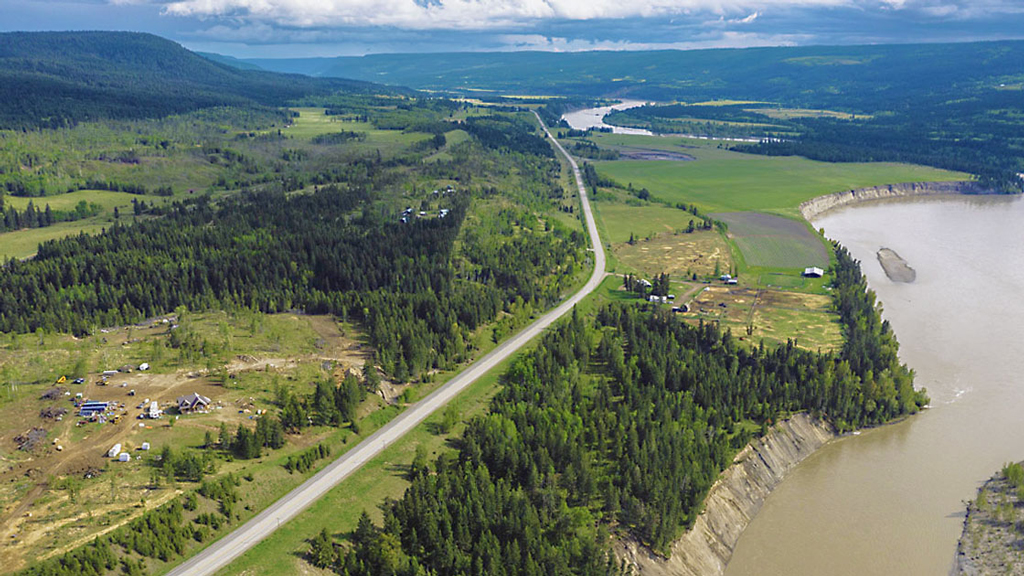The B.C. government is gathering input in preparation for roadwork at 10 sites along the Highway 97 corridor in the Cariboo region that bore the brunt of major landslides and washouts in 2020 and 2021.
Slope stabilization and interim works have taken place at seven of the sites to improve safety while three sites are currently closed. A technical analysis is presently being done to look at various options for the sites.
The area, between Williams Lake and just north of Quesnel, has been particularly hard hit by changing weather patterns. July 2020 marked extremely wet seasons in the Cariboo region, particularly in Williams Lake and Quesnel. The summer of 2021, meanwhile, marked B.C.’s worst wildfire season on record.
“The very wet spring and summer months of the past couple of years, combined with the snow melt and effects of wildfires, has brought more water into the ground than usual and has caused unprecedented landslides and road impacts since 2020 in the Cariboo region,” David Crebo, communications director at the Ministry of Transportation and Infrastructure (MTI), said in a statement prepared for the Journal of Commerce.
“These events have resulted in localized impacts in the Cariboo as well as to regional routes, including Highway 97 that connects many communities and plays a key role in B.C.’s northern natural resource sector.”
Crebo says the slides are complex and challenging to mitigate. They are often massive and extremely difficult to stabilize.
The venture is known as the Cariboo Road Recovery Projects (CRRP). Over the coming months project teams will be engaging with communities, local governments, First Nations and stakeholders to discuss potential solutions for each project site.
Currently, $146 million has been committed for engineering work. The sites are Highway 20 at Hodgson/Dog Creek Road; Soda Creek-MacAlister Road; Highway 97 at Cuisson Creek; Durrell Road; Bastin Road at Bastin Hill; Kersley Dale Landing Road; Quesnel-Hydraulic Road; Blackwater Road at Knickerbocker Road; Highway 97 at Cottonwood Hill; and Quesnel-Hixon Road.
“Each of the project sites that fall within the Cariboo Road Recovery Projects is undergoing a thorough, multi-phase, technical-driven process,” explained Crebo.
All 10 projects are moving ahead independently and the intention is to provide solutions as soon as possible. Timelines will vary due to the nature and complexity of each site.
Interim paving has been done at Highway 97 at Cottonwood and drainage improvements have taken place on Bastin Road at Bastin Hill. A temporary access road at Kersley Dale Landing has been built to improve safety and reliability for drivers.
The projects are being done in four phases. In the first phase, MTI teams defined the problem and did a needs assessment, considering existing, future and project conditions at each site to help inform the direction of potential options.
The projects are now in their second phase which entails generating a concept, looking at a number of options at each site, and doing the technical analysis.
“As part of our design process, engineers and consultants are considering how future climate events will affect infrastructure and what can be done to make our roads more resilient, so they remain reliable and open,” Crebo stated. “These options are being assessed against multiple criteria to help narrow our list as we head into the next phase.”
In March 2022, the MTI hosted a public engagement period to provide an overview and update on the projects and give the public an opportunity to provide feedback.
Input received through the community engagement will be considered, along with technical and policy considerations, as well as cost estimates, as the MTI develops long-term solutions for each site.
In the third phase of the project, short-listed options will be put through a detailed analysis to evaluate the choices against a list of criteria.
This will allow the MTI to identify a preferred solution.
The fourth and final phase is implementation. Once a long-term solution receives approval by government, the MTI will develop workplans to deliver the project. The plans could include further stabilization of slopes, additional restoration, road relocation or potential permanent alternative access routes.
“To help inform long-term solutions, ongoing geotechnical investigations, including aerial surveys, drilling and ground movement monitoring are taking place. Interim and construction works, as well as regular and winter maintenance, will also be undertaken to improve safety and rideability.”
Crebo said design engineers and consultants are also considering what can be done to make the roads more resilient, so they remain reliable and open during future extreme weather events. Some works may include upsizing culverts, bridging areas of concern where culverts are no longer suitable, redesign of drainage channels for future flow, and better armouring of slopes.
Long-term, the MTI is exploring climate resilient solutions for Cariboo roads that keep them open and safe, he said.
The Government of British Columbia, with federal support, has already made significant investments in climate resilient work and strategies for infrastructure since 2017, allotting $230 million in the Cariboo alone.











Recent Comments
comments for this post are closed